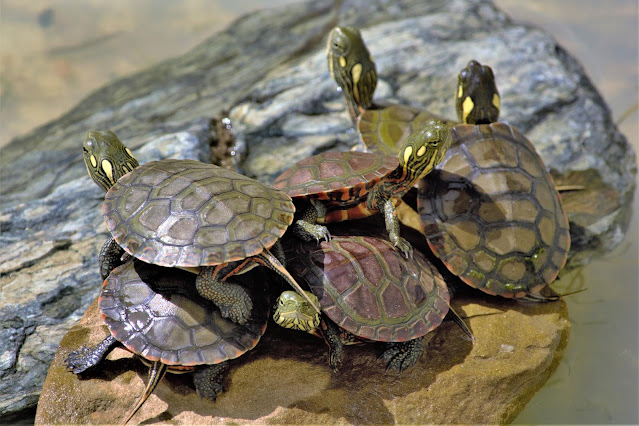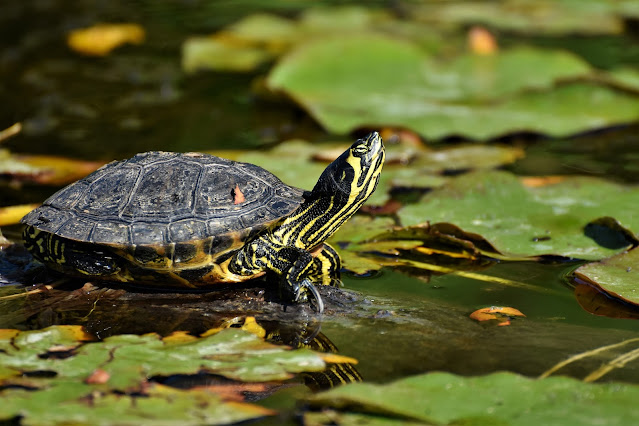Painted turtles are named as such due to their elaborate shell markings, however they may likewise be known as Chrysemys picta, the Eastern painted turtle, the Southern painted turtle, the midland painted turtle, or the Western painted turtle. Despite what you call them however, painted turtles require unique consideration paid to their water quality, nook temperatures, and the food they are taken care of to give ideal consideration to these sea-going turtles.
About Painted Turtles
The typical painted turtle develops to be somewhere in the range of four and 12 inches long with guys being more modest than females. In the wild, painted turtles can live to be more than 50 years of age and are tracked down in lakes and around little lakes, frequently congregating on logs to sun themselves and get dry. In colder climates, they will rest.
Like other amphibian turtles, for example, map turtles and red-eared sliders, painted turtles are not great for families with little youngsters or safe compromised people. Salmonella is something all reptiles can hold onto and everybody ought to clean up when dealing with any amphibian turtle.
Lodging Painted Turtles
Since painted turtles are oceanic turtles, they will invest most of their energy swimming and the remainder of their time eating and luxuriating on a dry land parcel in the sun. The consideration of painted turtles is like that of a pet fish in that they need a tank primarily loaded up with water however dissimilar to a fish, they likewise need some place to dry dock. An enormous fish tank that will hold 100 gallons of water or more is essential for a totally mature painted turtle, however some turtle proprietors will likewise utilize a youngster pool, lake liner, or other huge plastic compartments.
Rock developed with bigger rocks to make an ocean side on one side of the tank serves well as a luxuriating region and dry-mooring station for your turtle. You can likewise utilize different drifting embellishments that are accessible at pet stores.
Food and Water
Painted turtles regularly eat their food while swimming, so things that float or that can be cut to the side of the nook are ideal. Oceanic turtle pellets are a decent staple eating routine, yet your turtle ought to likewise get a few new verdant vegetables. Dim, mixed greens like romaine, dandelion greens and new parsley ought to be presented consistently. These can be put in the water or cut to the side of the tank with a pull cup cut sold in the fish division at the pet store.
New, slashed apple pieces and freeze-dried shrimp can be presented as treats every once in a while, however shouldn't make up in excess of 10% of your turtle's eating regimen. Painted turtles will likewise eat a few bugs and fish. Greasy fish like goldfish ought to be kept away from, yet an infrequent guppy, cricket, or worm can be presented for assortment.
It ought to be obvious that water quality is vital to creatures that spend most of their lives swimming, and sea-going turtles are no exemption. Grimy water can cause various medical conditions for an oceanic turtle.
Quality water channels are an unquestionable requirement for any painted turtle nook to keep the water spotless, clear, and new. Sub channels and canister channels are both great choices and ought to be continually hurrying to give filtration as well as air circulation to your painted turtle's water.
Light
Whenever housed inside, UVB lighting and supplemental intensity lights ought to be given to amphibian turtles. Painted turtles don't require incredibly warm temperatures, yet they will be more dynamic and eat better assuming their house is warmed appropriately. In the event that temperatures are permitted to dip under 70 degrees, your turtle might become dormant, not eat well, and begin to go into hibernation. Turtles that are housed external in hotter months ought to be brought inside when the external temperature gets excessively cool.
UVB lighting ought to be accommodated 12 hours every day, no matter what the season, as an UVB bulb. This bulb ought to likewise be supplanted at regular intervals since the imperceptible UVB beams lapse before the noticeable white light does. Painted turtles that are housed outside needn't bother with this supplemental UVB light since they get normal UVB beams from the sun.
Intensity can be given as intensity lights or fired heat producers. A temperature inclination ought to be made so your turtle has temperatures somewhere in the range of 70 and 95 degrees to look over. The hottest side of the tank ought to be a similar side as the luxuriating or dry dock region.
Normal Health Problems
Painted turtles are moderately simple to really focus on with the legitimate arrangement and diet yet they are not invulnerable to medical problems.
Parasites: Intestinal parasites are tracked down normally in many reptiles, including painted turtles, yet they can turn into an issue for your turtle in the event that they overpopulate the digestive system. Yearly waste parasite tests ought to be performed by your exotics veterinarian.
Diseases: If water quality is an issue, your turtle can get skin, shell, and ear contaminations from the messy water. If an excess of green growth is developing on your turtle's shell or skin, utilize a delicate toothbrush to assist with keeping it clean. Ear contaminations from unfortunate water quality will show as huge knocks behind your turtle's eyes and should be tended to by your vet.
Hypovitaminosis A: When a painted turtle doesn't get a legitimate eating regimen it might foster an absence of vitamin A in its body considered hypovitaminosis A. Enlarged eyes, crude skin, stomatitis, and nasal waste can all be side effects of this problem.
Metabolic bone illness: Without legitimate UVB lighting and calcium, painted turtles will foster metabolic bone sickness and shell deformations.
In the event that you suspect your turtle has a medical problem get him in to consider a vet to be as soon as could really be expected. With your assistance, your turtle can carry on with a long and sound life.







.png)

.png)
.png)
.png)










